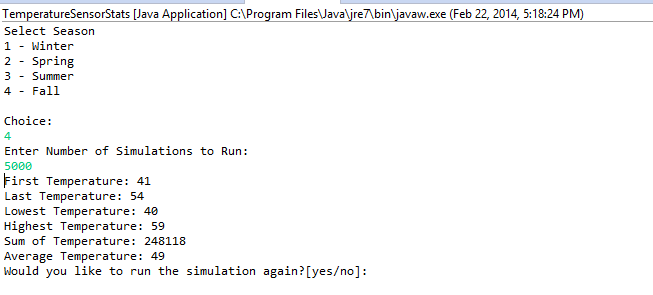Description
In this lab a TemperatureSensor class was created and contains all the set and get methods that will be used in the main program. A second class, TemperatureSensorStats, will implement the application. It will contain a menu which prompts the user to choose a season and number of simulations they would like to run. When the application is run the following information will be displayed.
- First temperature generated
- Last temperature generated
- Lowest temperature generated
- Highest temperature generated
- Total sum of all temperatures generated
- Average for the season
The application also validates the user inputs and upon successfully inputting the correct data the application executes and displays the above mentioned information.
Code
TemperatureSensor.java
//Ryan Lawrence
//TemperatureSensor.java contains all the methods used in the main java source.
import java.util.Random;
public class TemperatureSensor {
private int numberOfSim;
private int firstTemp = 0, lastTemp = 0, lowTemp=999999, highTemp=0, sumTemp =0, randTempValue,avgTemp=0;
Random randTemp = new Random();
//Set method used to change the private variable
public void setNumberOfSim(int numOfSim){
numberOfSim = numOfSim;
}
//Method used to reinitialize all the variables
public void reInitialize(){
firstTemp=0;
lastTemp=0;
lowTemp=999999;
highTemp=0;
sumTemp =0;
avgTemp=0;
}
//Methods used for each season
public void getWinterTemp(){
for(int count = 0; count < numberOfSim; count++){
randTempValue = 20 + randTemp.nextInt(20); //Generate a random number between 20-40
//captures the first iteration of the loop
if (count == 0){
firstTemp=randTempValue;
}
//checks to see if the current random temperature is lower than the stored lowest.
if (randTempValue <= lowTemp){ lowTemp = randTempValue; } //checks to see if the current random temperature is higher than the stored highest. if (randTempValue >= highTemp){
highTemp = randTempValue;
}
//Stores the last value in the iteration
if (count == (numberOfSim - 1)){
lastTemp = randTempValue;
}
//Adds all the Generated Temperatures
sumTemp += randTempValue;
}
//Calculate the average of all the generated temperatures.
avgTemp = sumTemp/numberOfSim;
}
public void getSpringTemp(){
for(int count = 0; count < numberOfSim; count++){
randTempValue = 40 + randTemp.nextInt(30);
if (count == 0){
firstTemp=randTempValue;
}
if (randTempValue <= lowTemp){ lowTemp = randTempValue; } if (randTempValue >= highTemp){
highTemp = randTempValue;
}
if (count == (numberOfSim - 1)){
lastTemp = randTempValue;
}
sumTemp += randTempValue;
}
avgTemp = sumTemp/numberOfSim;
}
public void getSummerTemp(){
for(int count = 0; count < numberOfSim; count++){
randTempValue = 70 + randTemp.nextInt(20);
if (count == 0){
firstTemp=randTempValue;
}
if (randTempValue <= lowTemp){ lowTemp = randTempValue; } if (randTempValue >= highTemp){
highTemp = randTempValue;
}
if (count == (numberOfSim - 1)){
lastTemp = randTempValue;
}
sumTemp += randTempValue;
}
avgTemp = sumTemp/numberOfSim;
}
public void getFallTemp(){
for(int count = 0; count < numberOfSim; count++){
randTempValue = 40 + randTemp.nextInt(20);
if (count == 0){
firstTemp=randTempValue;
}
if (randTempValue <= lowTemp){ lowTemp = randTempValue; } if (randTempValue >= highTemp){
highTemp = randTempValue;
}
if (count == (numberOfSim - 1)){
lastTemp = randTempValue;
}
sumTemp += randTempValue;
}
avgTemp = sumTemp/numberOfSim;
}
//method diplays all the information captured
public void getOutputs(){
System.out.printf("First Temperature: %d\n", firstTemp);
System.out.printf("Last Temperature: %d\n", lastTemp);
System.out.printf("Lowest Temperature: %d\n", lowTemp);
System.out.printf("Highest Temperature: %d\n", highTemp);
System.out.printf("Sum of Temperature: %d\n", sumTemp);
System.out.printf("Average Temperature: %d\n", avgTemp);
}
}
TemperatureSensorStats.java
//Ryan Lawrence
//TemperatureSensorStats.java implements the TemperatureSensor.java
import java.util.Scanner;
import java.util.InputMismatchException;
public class TemperatureSensorStats {
public static void main(String[] args) {
String loopControl = "yes"; //loop control for program
Scanner loopControlInput = new Scanner(System.in); //scanner object
TemperatureSensor tempSensor = new TemperatureSensor(); //creates a new TemperatureSensor object
Scanner numSim = new Scanner(System.in);
Scanner season = new Scanner(System.in);
//while loop used to keep the program running until user enters no
while(loopControl.equals("yes")){
int choice;
int numSimValue;
//Exception handling- tests to ensure the user enters an integer
try{
System.out.println("Select Season");
System.out.println("1 - Winter\n2 - Spring\n3 - Summer\n4 - Fall\n");
System.out.println("Choice: ");
choice = season.nextInt();
}
//If the user enters anything that is not an integer an error is displayed and the program restarts
catch (InputMismatchException inputMismatchException){
System.out.printf("\nException: %s\n", inputMismatchException);
season.nextLine();
System.out.println("Must enter an Integer\n");
continue;
}
//If statement is used to ensure the user enters a value from the choices given
//If they do not the program restarts
if(choice==0 || choice > 4){
System.out.println("Invalid Choice\n");
continue;
}
//Exception handling- tests to ensure the user enters an integer
try{
System.out.println("Enter Number of Simulations to Run: ");
numSimValue = numSim.nextInt();
}
//If the user enters anything that is not an integer an error is displayed and the program restarts
catch(InputMismatchException inputMismatchException2){
System.out.printf("\nException: %s\n", inputMismatchException2);
numSim.nextLine();
System.out.println("Must enter an Integer. Restarting Program\n");
continue;
}
//set method called
tempSensor.setNumberOfSim(numSimValue);
//switch statement used to determine which get method to use
switch (choice){
case 1:
tempSensor.getWinterTemp();
tempSensor.getOutputs();
break;
case 2:
tempSensor.getSpringTemp();
tempSensor.getOutputs();
break;
case 3:
tempSensor.getSummerTemp();
tempSensor.getOutputs();
break;
case 4:
tempSensor.getFallTemp();
tempSensor.getOutputs();
break;
}
tempSensor.reInitialize(); //reinitialize all the variables of the object
//Prompts the user, if they would like to run the program again
System.out.println("Would you like to run the simulation again?[yes/no]: ");
loopControl=loopControlInput.nextLine();
}
}
}
Screenshot



